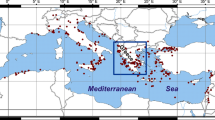Abstract
Morphostructural zoning (MSZ) scheme of the Himalayan arc region as obtained from a joint study of topographic, geological and tectonic maps as well as satellite imagery is analysed. Three types of morphostructures have been determined: territorial units (blocks of different ranks), linear zones limiting these blocks (lineaments) and intersections of the lineaments (knots). Comparison of MSZ scheme with the know seismicity indicates epicenters of strong earthquakes (M≥6·5) clustered around some of these knots. Pattern recognition method is used to determine seismically potential areas for the occurrence of recognition method is used to determine seismically potential, for the occurrence of strong earthquakes of magnitude ≥M 0. We have carried out two such studies for the Himalayan arc region, one forM 0=6·5 and the other forM 0=7·0. Out of a total number of 97 knots, 48 knots are found to be seismically potential for the occurrence of earthquake ofM≥6·5. The results of the study forM 0=6·5 were presented in the symposium on “Earthquake Prediction” held in Strasbourg, France, March 1991 (Gorshkovet al 1991). The epicenter of Uttarkashi earthquake of magnitude,M b=6·6 that occurred in the late hours of 19th October 1991 (UTC) lies in the vicinity of one such knot. The second study carried out subsequently shows that only 36, knots are potential for the occurrence of earthquakes ofM≥7·0, which include the knot, associated with theUttarkashi earthquake.
Similar content being viewed by others
References
Dasgupta S, Mukhopadhyay M and Nandy D R 1987 Active transverse features in the central portion of the Himalaya;Tectonophysics 136 255–264
Filimonov M, Zhidkov M and Tumarkin A 1989 Recognition of Earthquake-Prone Areas. XVIII. Southern America Andes (M≥7·0);Computational Seismology 23 111–125 (in Russian)
Ganser A 1964The Geology of the Himalayas (New York: Interscience) pp. 289
Ganser A 1974 The Himalayas; In:Mesozoic-Cenozoic orogenic belts (Edinburgh: Scottish Academic Press) pp. 326–339
Ganser A 1983Geology of the Bhutan Himalaya (Basel-Boston-Stuttgart: Birkhauser Verlag) pp. 176
Gelfand I, Guberman Sh, Izvekova M, Keilis-Borok V and Rantsman E 1972 Criteria of high seismicity, determined by pattern recognition;Tectonophysics 13 415–422
Gorshkov A, Filimonov M, Chetty T R K and Rao M N 1991 Identification of earthquake-prone areas in the Himalaya belt,EUG VI. Abstracts. Terra, March Strasbourg p. 164
Gvishiani A, Soloviev A 1981 About proximity of strong earthquake epicenters to intersections of morphostructural lineaments in the South America territory;Computational Seismology 13 45–50 (in Russian)
Gvishiani A, Gorshkov A, Rantsman Eet al 1988Identification of earthquake prone areas in regions of moderate seismicity (Moscow: Nauka) pp. 175 (in Russian)
Khain V 1984Regional geotectonics. Alpine Belt (Moscow: Nedra) pp. 344 (in Russian)
Mukhopadhyay M 1984 Seismotectonics of transverse lineaments in the Eastern Himalaya and its foredeep;Tectonophysics 109 227–240
Olta Y, Akiba C (eds) 1973Geology of the Nepal Himalayas (Sapporo: Saikom Publishing Co. Ltd.) pp. 290
Rantsman E 1979Places of earthquakes and morphostructure of mountain countries (Moscow: Nauka) pp. 170 (in Russian).
Varunoday, Gaur V K and Wason H R 1979 Spatial prediction of earthquakes in Kumaon Himalaya by pattern recognition;Mausam 30 253–264
Valdia K S 1976 Himalayan transverse faults and folds and their parallelism with subsurface structures of North Indian plains;Tectonophysics 32 353–386
Valdia K S 1984 Tectonics of folded areas around Indian platform;Proceedings of the 27 International Geological Congress (Moscow: Nauka) Vol. 5, 89–11 (in Russian)
Windley B F 1988 Tectonic framework of the Himalaya, Karakorum and Tibet, and problems of their evolution;Philos. Trans. R. Soc. London A326 3–16
Author information
Authors and Affiliations
Rights and permissions
About this article
Cite this article
Bhatia, S.C., Chetty, T.R.K., Filimonov, M.B. et al. Identification of potential areas for the occurrence of strong earthquakes in Himalayan arc region. Proc. Indian Acad. Sci. (Earth Planet Sci.) 101, 369–385 (1992). https://doi.org/10.1007/BF02893012
Received:
Issue Date:
DOI: https://doi.org/10.1007/BF02893012




